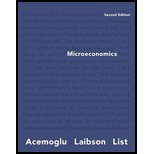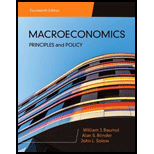
The nature of “Homo economicus” in mainstream economics and its nature in social spheres.
Explanation of Solution
The standardized version of “Homo economicus” considers individuals to be fundamentally rational. Rationality is defined by individuals undertaking actions and choices that provide the self with maximum benefit. It is self-satiating at its core and presumes that an individual prioritizes one’s own needs over any other’s.
The “Homo economicus” model understood by behavioral scientists is different. While it is based on the principle of an individual’s satisfaction, it goes by a system called “altruism model”, where it describes individuals’ interests to be contingent on the interests (can be both beneficial or detrimental) of other individuals.
Hence, instead of assuming economic agents to simply be self-serving, social scientists consider economic agents to derive utility from others as well.
Want to see more full solutions like this?
Chapter 18 Solutions
Microeconomics (2nd Edition) (Pearson Series in Economics)
- Not use ai pleasearrow_forwardHelp me write these economic analysis for Macys one paragraph) Company name/current state of operation of this company - Describe the company's performance in the present economy, whether it is growing or declining, and who are its competitors?arrow_forwardnot use ai pleasearrow_forward
- The following graph plots daily cost curves for a firm operating in the competitive market for sweatbands. Hint: Once you have positioned the rectangle on the graph, select a point to observe its coordinates. Profit or Loss0246810121416182050454035302520151050PRICE (Dollars per sweatband)QUANTITY (Thousands of sweatbands per day)MCATCAVC8, 30 In the short run, given a market price equal to $15 per sweatband, the firm should produce a daily quantity of sweatbands. On the preceding graph, use the blue rectangle (circle symbols) to fill in the area that represents profit or loss of the firm given the market price of $15 and the quantity of production from your previous answer. Note: In the following question, enter a positive number regardless of whether the firm earns a profit or incurs a loss. The rectangular area represents a short-run of thousand per day for the firm.arrow_forwardNot use ai pleasearrow_forwardSouth Africa faces the triple challenge of poverty, inequality and unemployment and the national minimum wage debate has pulled on all three threads to make arguments for and against this policy. Discuss the theoretical implications of a national minimum wage, and touching on each of the three challenges South Africa faces, discuss some arguments for how this policy may affect them.arrow_forward
- In the context of the article below, discuss the Minister’s position in light of the principles of fairness as they relate to taxation. SA's work visa reform plans slowed by tax issues South Africa’s plan to attract more professionals to its skills-starved economy through the introduction of a so-called nomad visa for remote workers has been slowed by the need to amend tax regulations. The impediment comes after an initial delay when changes to the visa regime had to be temporarily withdrawn because mandatory public consultation procedures hadn’t been followed. President Cyril Ramaphosa announced his intention to introduce a remote-working visa in his 2022 state-of-the-nation address. “There is just a tax-related matter that needs to be addressed in the regulations,” Leon Schreiber, the country’s Home Affairs Minister, said in a response to queries. “Once that is done, the department will commence with the rollout.” South Africa’s byzantine work permit regime, which means…arrow_forwardAssume that an economy has an inflationary gap. Compare the use of fiscal policy with the use of monetary policy to remove the gap. Assume a closed economy. Use graphs to illustrate.arrow_forwardSuppose Person A is looking for a health insurance plan on Oregon's health insurance marketplace and they find one with the following details: Monthly Premium: $331 Deductible: $5,000 Primary care visit to treat injury or illness: $35 copay Imaging (CT/PET Scans MRIs): 40% coinsurance after deductible Ambulance: 40% coinsurance after deductible Inpatient hospital stay: 40% coinsurance after deductible Suppose further that Person A purchases this plan and it takes effect in January 2022. The cost Person A pays per month for this health insurance is equal to _. Person A must pay. before coinsurance kicks in. 0000 $35; $5,000 $35; $331 $331; $5,000 $331; $35 Multiple Choice 1 point Suppose Person A is looking for a health insurance plan on Oregon's health insurance marketplace and you find one with the following details: Monthly Premium: $331 Deductible: $5,000 Primary care visit to treat injury or illness: $35 copay Imaging (CT/PET Scans MRIs): 40% coinsurance after deductible Ambulance:…arrow_forward
 Economics (MindTap Course List)EconomicsISBN:9781337617383Author:Roger A. ArnoldPublisher:Cengage Learning
Economics (MindTap Course List)EconomicsISBN:9781337617383Author:Roger A. ArnoldPublisher:Cengage Learning

 Exploring EconomicsEconomicsISBN:9781544336329Author:Robert L. SextonPublisher:SAGE Publications, Inc
Exploring EconomicsEconomicsISBN:9781544336329Author:Robert L. SextonPublisher:SAGE Publications, Inc
 Microeconomics: Principles & PolicyEconomicsISBN:9781337794992Author:William J. Baumol, Alan S. Blinder, John L. SolowPublisher:Cengage Learning
Microeconomics: Principles & PolicyEconomicsISBN:9781337794992Author:William J. Baumol, Alan S. Blinder, John L. SolowPublisher:Cengage Learning





